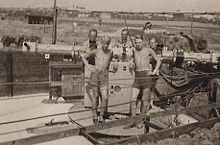Air Force Aid
Luftwaffe helper (abbreviated LwH ) was the official name for 15- to 17-year-old high school students born between 1926 and 1928, who were deployed as flak helpers from February 1943 as part of the military service in the defense of the Reich in the air war . From 1944, not only high school students were drafted as air force helpers: apprentices from the industrial and commercial sectors were also deployed as air force helpers from the 1928 class.
Air force helpers did not have the status of soldiers. Like soldiers, they performed tasks on guns and equipment and lived in the flak positions like them, but were at the same time students who were taught by teachers. Officially, they were considered members of the Hitler Youth , which they often disliked. The Hitler Youth armband had to be worn with the “ dress uniform ” . Three institutions were involved in determining the deployment of air force helpers: the air force , the Hitler Youth and the school. Voluntary reports were not possible, the pupils were delegated to the assignment class by class and within the school classes by year.
The Luftwaffe helpers were supposed to create replacements for soldiers who were fit for the front who were withdrawn from the flak positions and sent to the front to make up for the losses there. 100 air force helpers replaced 70 soldiers released for the front. There were concerns about the use of air force helpers, so Martin Bormann , head of the party chancellery , feared the influence on the mood of the population. The aim was to avoid the impression that the Wehrmacht had bled out and had to resort to young people as soldiers.
Luftwaffe helpers were usually promoted to Luftwaffe Oberhelfer (LwOH) after nine months of service and then wore a silver braid on their shoulder pieces. As a further measure, in order to take advantage of the young people's desire for prestige, the anti-aircraft combat badge was awarded in rare cases .
In the Nazi propaganda male youths were in puberty especially Ritterkreuzträger , " aces " and successful submarine pre-recorded -Fahrer as impressive figures. In the case of air force helpers, this usually stopped; as a rule, they were no longer receptive to this heroic and pathetic propaganda.
In the years 1943 to 1945, a total of 200,000 air force and naval helpers were probably on duty. Exact data on casualties among air force helpers do not exist, but reports of numerous direct hits in flak positions suggest high casualties.
literature
- Manuel Werner: Power and helplessness of young air force helpers - an example from the air base and concentration camp Echterdingen / Filder . In: State Center for Political Education Baden-Württemberg / Educators Committee of the Society for Christian-Jewish Cooperation Stuttgart (ed.): Through fascination for power - the fascination of power. Building blocks for the relationship between power and manipulation. Handouts for teaching. Stuttgart 2003.
- Rolf Schörken : Student soldiers - shaping a generation . In: RD Müller, HE Volkmann (Ed. On behalf of MGFA ): The Wehrmacht: Myth and Reality. Oldenbourg, Munich 1999, ISBN 3-486-56383-1 , p. 456 ff.
- Dieter Noll : The adventures of Werner Holt - novel of a youth.
- Paul Emunds (Ed.): At 15 to the cannons. Self-published by the Kaiser-Karls-Gymnasium, Aachen 1975. [Documentation with very detailed eyewitness reports a. Ä.]
- Hans-Dietrich Nicolaisen: The use of the air force and naval helpers in the 2nd World War. Presentation and documentation. Self-published, Büsum 1981, 667 pages.
- Ludger Tewes : Youth in War Of Air Force helpers and soldiers. Reimar Hobbing Verlag, Essen 1989. ISBN 3-920460-49-9 . Foreword by Rolf Schörken .
- Franz-Josef Schmeling: Marked by the war for a lifetime. Former Air Force and Navy aides respond 50 years later. Osnabrück 1997, ISBN 3-87898-358-1 , 247 pages.
- Air force helper from Neuss - Neuss eyewitness talks conducted by Heinz Günther Hüsch. Ed .: Association of Heimatfreunde Neuss e. V. 2010, ISBN 978-3-934794-22-1 .
- Wolfgang Finkbeiner: Air force helpers from Ulm and Neu-Ulm. With 20 contributions from contemporary witnesses and a. Manfred Rommel . Süddeutsche Verlagsgesellschaft, Ulm 2006, ISBN 978-3-88294-372-6 .
Movie
- Luftwaffe Helpers - German TV film from 1980, directed by Volker Vogeler.
Web links
- Youth in Germany 1918 to 1945: Luftwaffe helpers (NS Documentation Center of the City of Cologne)
- Gerhard E. Sollbach: "Student-Soldiers". The use of air force helpers . historicum.net; Retrieved January 5, 2013

